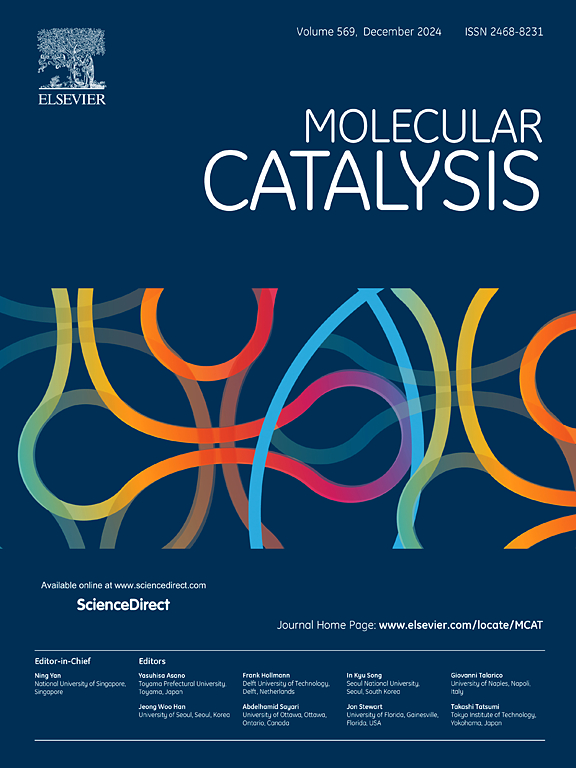WO3-MoO3共掺杂提高了V2O5/TiO2催化剂的低温NH3-SCR活性
IF 4.9
2区 化学
Q2 CHEMISTRY, PHYSICAL
引用次数: 0
摘要
为了提高V2O5/TiO2催化剂在氨(NH3-SCR)选择性催化还原中的低温性能,在V2O5/TiO2催化剂中加入钨(W)和钼(Mo)。采用初湿浸渍法制备了一系列V-W-Mo/TiO2催化剂。利用拉曼光谱、x射线光电子能谱(XPS)和NH3程序升温解吸(NH3- tpd)等先进表征技术,研究了WO3和MoO3共掺杂对V/Ti催化剂性能的影响。研究结果表明,VW10Mo5.5/TiO2催化剂表现出优异的性能,在190°C至400°C的宽温度范围内保持80%以上的NO转化率。相比之下,V2O5/TiO2催化剂需要230℃的温度才能达到相同的NO转化率,这表明WO3和MoO3的共掺杂使NO高效转化的温度降低了40℃。拉曼光谱和XPS分析表明,WO3和MoO3的共掺杂增加了钒钛基催化剂上的V4+组分和化学吸附氧的比例,提高了钒钛基催化剂的低温NH3-SCR活性。此外,WO3和MoO3的共掺杂显著影响了钒的迁移和聚集,使表面单体氧化钒转变为表面聚合氧化钒。聚合物氧化钒是提高催化剂NH3-SCR活性的关键物质,在低温条件下,这些物质的高比例显著提高了NH3-SCR活性。本文章由计算机程序翻译,如有差异,请以英文原文为准。

Co-doping WO3-MoO3 enhances the low-temperature NH3-SCR activity of V2O5/TiO2 catalysts
To improve the low-temperature performance of V2O5/TiO2 catalysts in the selective catalytic reduction of ammonia (NH3-SCR), tungsten (W) and molybdenum (Mo) were incorporated into the V2O5/TiO2 catalyst. A series of V-W-Mo/TiO2 catalysts were synthesized using the incipient wetness impregnation method. Advanced characterization techniques, including Raman spectroscopy, X-ray photoelectron spectroscopy (XPS), and NH3 temperature-programmed desorption (NH3-TPD), were utilized to examine the effects of WO3 and MoO3 co-doping on the performance of V/Ti catalysts. The findings reveal that the VW10Mo5.5/TiO2 catalyst demonstrated exceptional performance, maintaining a NO conversion rate above 80 % across a broad temperature range of 190 °C to 400 °C. In comparison, the V2O5/TiO2 catalyst required a temperature of 230 °C to achieve the same NO conversion rate, indicating that the co-doping of WO3 and MoO3 lowered the temperature for efficient NO conversion by 40 °C. Raman spectroscopy and XPS analyses revealed that the co-doping of WO3 and MoO3 increased the proportion of V4+ species and chemically adsorbed oxygen on the vanadium-titanium-based catalyst, which enhances low-temperature NH3-SCR activity. Furthermore, the co-doping of WO3 and MoO3 significantly affected the migration and aggregation of vanadium species, converting surface monomeric vanadium oxide species into surface polymeric vanadium oxide species. Polymeric vanadium oxide species are crucial for enhancing the NH3-SCR activity of the catalyst, with a high proportion of these species significantly boosting the NH3-SCR activity under low-temperature conditions.
求助全文
通过发布文献求助,成功后即可免费获取论文全文。
去求助
来源期刊

Molecular Catalysis
Chemical Engineering-Process Chemistry and Technology
CiteScore
6.90
自引率
10.90%
发文量
700
审稿时长
40 days
期刊介绍:
Molecular Catalysis publishes full papers that are original, rigorous, and scholarly contributions examining the molecular and atomic aspects of catalytic activation and reaction mechanisms. The fields covered are:
Heterogeneous catalysis including immobilized molecular catalysts
Homogeneous catalysis including organocatalysis, organometallic catalysis and biocatalysis
Photo- and electrochemistry
Theoretical aspects of catalysis analyzed by computational methods
 求助内容:
求助内容: 应助结果提醒方式:
应助结果提醒方式:


